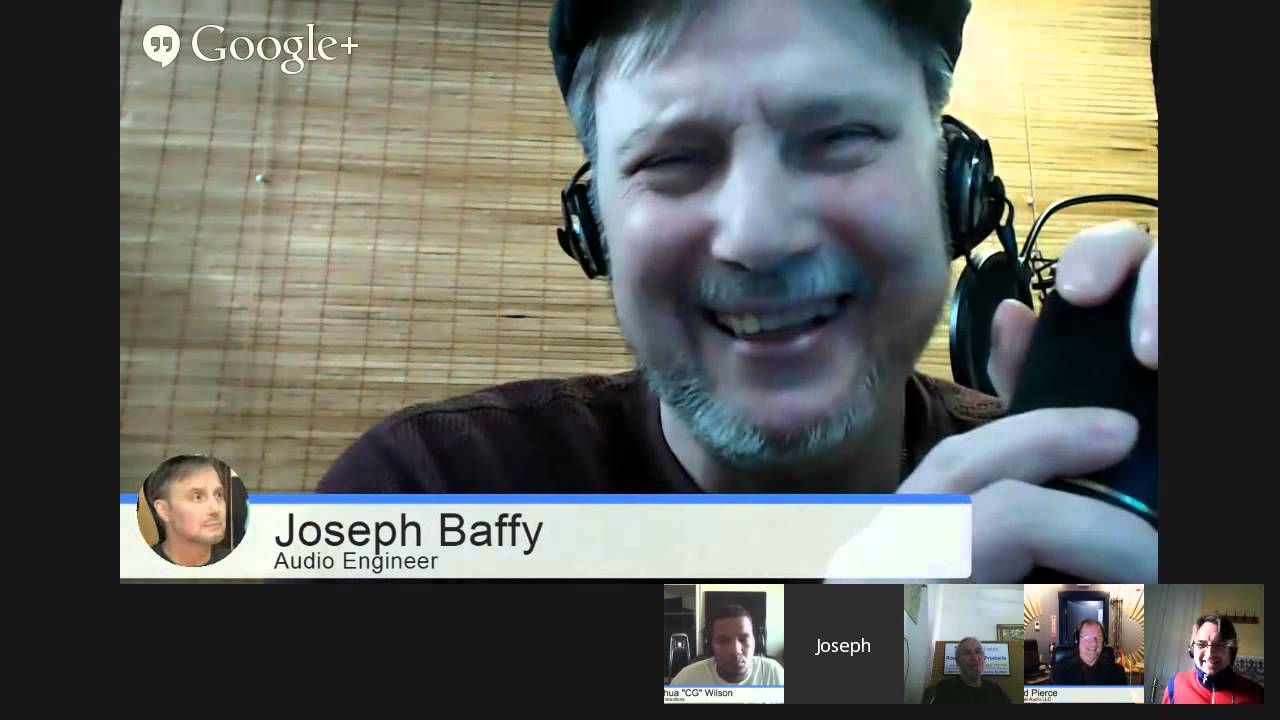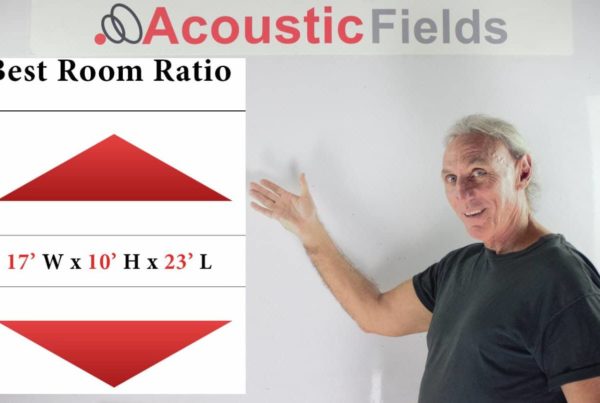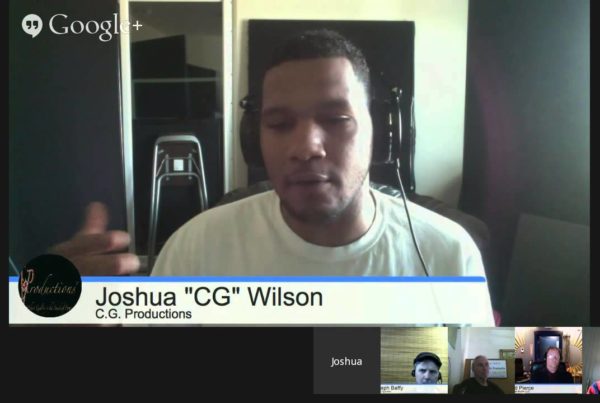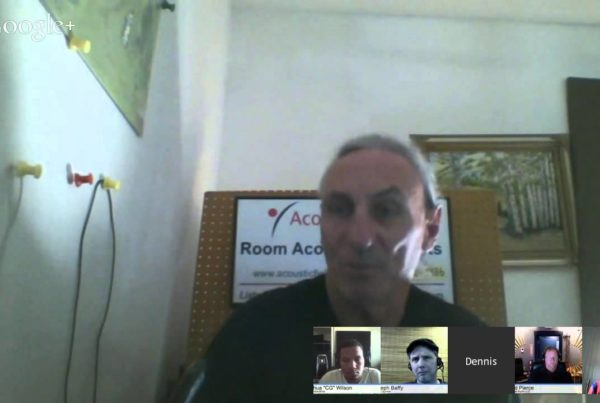In another of our monthly Google Hangouts with experienced and talented audio engineers Brad Pierce, Joseph Baffy and Joshua Wilson, we continued in our efforts to bridge the gap between what you are hearing as an engineer and how the room is causing that problem. The following video and transcript comes from one particular section where we addressed the issue “Recording acoustic guitar mic techniques”. If you would like to see the full hour and a half discussion you can see the video further down the page.
Dennis: I was thinking of designing a room with LED panels throughout all the surfaces. And each section of the LED panels will respond to certain frequency groupings. And then you could sit in a chair and watch the colors of all the surfaces change consistently. And then you’d have to say to yourself “Alright, how do I capture all that in a microphone?” And the answer will be you could not. It’s too complicated, there’s too many reflections just imposed upon each other. So then you’d have to step back a little bit and go okay “How do I get most of that energy into my recordings?” and the answer is probably you can’t do that either.
So then you have to synthesize it down a little bit like “how do I get enough of the energy to give my audience an emotional connection to the music? What are those variables involved?” Joshua just said that you know he’s going a little bit more on feelings now. Well he’s going on feelings because that’s what we should all be going on but we can’t because our rooms are so bad and that’s the problem. I’m beginning to realize that the room is just, so, so critical that I think microphones are just like audio equipment. I think you need a certain level of quality in the microphone and that’s reflected in the price point. Do you need 5000 dollars worth in the price point quality? I don’t think so.
I bring people to tears with 300 dollars of garage sale here in my studio and I’m going to argue that’s not the case. Now I think there probably is a case to be made for microphones and quality and price and all of that as minimum levels. But it’s more about technique. It’s more about understanding what’s going on with those instruments that you’re using. If you take an accomplished guitar player, what do you first notice about them? Every time I see somebody who plays guitar and is really good in my mind and experienced based, I notice one thing stands out, without hesitation and that’s the master and control of their instrument. They know that instrument inside out completely. They know that if they turn into a little bit this way or that way in front of the microphone, they get this or that sound differential. They have complete control over that instrument.
I think we need a little bit more of that thinking, a little bit more of that mastery if you will, when it comes to recording techniques and also room acoustics, of which I have no doubt. But I always see that with your good players. I remember one time I was in New York and I was involved in a recording with Eric Clapton and he came into the studio and the first thing I did back then was I knew that this guy had a complete mastery of his instrument. Well he didn’t bring any instruments into the recording session. He just came in. So I rented from another studio and I think it was a Martin D6 and I can’t remember the exact name but it was a really good martin guitar and back then that’s when martin’s were made well and farmed out to a China.
And what was the first thing that he did? He went right for the guitar. He picked it up and started playing. And the mastery that he had over his instrument was incredible and then I watched the recording engineer fumble around, trip over cables and knock microphones down. The opposite, no control. He didn’t have idea what he was doing. So you had these two quality paradigms I guess against each other and comparing and contrasting in the same room and I just sat back and I took a deep breath and I said well there you go. You know there’s a partial, there’s a partial reason for why we’re not getting consistency and quality.
Joseph: There you go. That is a really good story Dennis. You know I didn’t want to make a microphone. I prefer to buy one but I lost my microphone cabinet, the entire thing and its contents and I bought three kits from someone who thought they were going to build microphones and a year later I still had them so I gave them about half their money back and my goal wasn’t to become a microphone maker. That’s not my goal. My goal is to capture really good music and mix really good music. But I wanted to teach myself something about a microphone because I truly believe that once you hit that 1000-1200 dollar mark, actually I think once you get a past 500 dollars, you at least, the increments of better get so much smaller in a product. You know to the point where this little gold mine around this thing might be 24 carat gold once I hit the 2500-3000 dollar range.
You know in other words that little 24 carat gold your whole thing doesn’t doing anything. You know it’s not helping the microphone do anything. It’s just an aesthetic thing. So you get my point you know so yes, I agree with 100% that the tool is absolutely only as good as the person using it. And you can have the best guitar player in the world and if you put a pencil condenser 2 inches away from the 12th fret, you’re going to get a crappy recording. Because it’s just not how it works. It’s not the end-all-be-all on how you do it.
Dennis: If you had a rate on a scale of 1 to 10, not the type of microphone that you’re using, let’s hold that variable constant, let’s go to the technique, the microphone technique of mic-ing your instrument, on a scale of 1 to 10 how important is that in the final quality of the product?
Joseph: The technique?
Brad: Yeah the technique on how you set the microphones up in space, in the room, the ratio of distance between the source and the walls, the floor and the ceilings, that makes up, that encompasses all of how that is going to come out in the end. Have to do next.
Joshua: I think anyone who masters whatever instrument it is be it voice or engineering or anything like that, like say with the guy on the guitar, he’s not an idiot when it comes to how thing are setup. Because you don’t master things like that by not knowing what it’s going to sound like . Just like the singer, they don’t need microphone technique, they know when something’s not right. Maybe because they know their voice more than say the engineer that they just came into contact with. You have to know something about the microphone technique at the least to be able to master something like that. In order to get a great sound from someone they know things about how to record in some kind of way. Be it the microphone technique.
Dennis: So on a scale of 1 to 10 back to our original discussion, microphone technique is a 10. Look at all the variables that go through with that. Distance from the instrument. Distance from the sound hole, distance from the fingers from the fret board, distance from a lot of different things. So we have distance. What are the other variables that we have to be concerned about when we’ve made a decision with the microphone, use this microphone technique to a live instrument?
Joseph: Time domain is a big.
Dennis: That’s distance right?
Joseph: Yes, that’s distance.
Dennis: Okay, what are some variables that we need to look at?
Joseph: If the distance gets even trickier, if you’re using two microphones because of the phase relationship that’s there. So that’s just compounds itself a little bit. You’re looking at where your reflections are coming from and not just what you point the microphone at but where the null point of that microphone is at.
Dennis: So we have a balance between direct energy and reflected energy. And let’s follow through with this logic because I think this might be something that we can look at. The direct energy is that straight line energy from the sound hole. Let’s use our guitar example. The reflected energy is obviously from the room sound so we’re paying a lot of attention to the direct energy. We’re measuring our distances, we’re moving back from the sound hole x, we’re moving a little bit left x, we’re moving a little right x, we’re all in time domain, the distance domain. We’re really focused on that domain and we’re not really focused on the reflections. The quality level, the frequency response, the balance between how much of this particular octave are we absorbing and our reflected energy, how much of this octave are we not getting and the reflected and the direct energy balance I think it has more attention paid to it.
I see that every day in my room, here in my studio. And it’s something that’s kind of been taken for granted. I think you mic an instrument, you get the microphones closer to it obviously to minimize room sound. But if you’re not using that technique, and you want more room, you have to be very, very careful that you really want more room. Is the room right? Is it the right combination of energies that you need in the delayed domain, the time delayed signature, delayed domain at the microphone composition? And I think we see a lot of emphasis towards the direct sound from the guitar but not so much concern for the other treatments that go on. And I’m going to argue that those are almost more important. Because you know what, there’s a lot more of them. There’s a lot more reflected energy than there is direct. I don’t know specifically what the ratio is but I’m going to guess that its a way more.
Joseph: 8 to 1. At least 8 sides to 1.
Dennis: Yes it’s six sides because we have six planes within the room. So assuming reflections come off all surfaces, floor ceilings and the four sidewalls, we have six planes of energy producing reflections. Then we have primary, secondary, tertiary, you know all kinds of lateral, all kinds of vertical, all kinds of oblique, probably there’s too many to count if we want to try to get scientific about it. But I think we need to pay as much attention to the direct energy as we do to the reflected energy. And I’m getting the impression from other recordings I listened to here at my studio that those that understand that produce better recordings.
Brad: I would agree with that. I think the source, the ratio of source and reflected energy is going to be determined by the distance to the source because you can’t really change the distance to the reflected energy if you’re in a room. I mean you can move it closer to a wall or further from the wall, I mean the furthest you can move your transducer, your microphone, is the center of your room but you have the ability to change the distance to the source. So by utilizing maybe the middle of the room where the reflected energy is going to be at the least amplitude, you can change the distance to the source and therefore change the ratio of the room to direct energy. And that’s pretty much what you have to play with.
And obviously if you have a room that is not balanced as far as reflected energy, you know if you have bumps and troughs in your room response, you’re going to want to get closer to the source to reject more of the room energy. But thinking about an acoustic guitar and how it sounds, generally it sounds best naturally when you’re a bit away from the instrument. So by treating your room and getting that balanced frequency response in your room, it’s going to allow you to record the source with a better quality and a better outcome. So really its the reflected energy in the room that’s going to enhance or detract from the outcome on a acoustic guitar recording. If you’re not doing some kind of effect with like close mic-ing or you’re going for some kind of special effect, you’re going for natural guitar sound.
Ali: What was it like Joshua for recording Terra in Dennis’s studio?
Joshua: Yeah I was about to mention that. Well basically this is my first time recording an acoustic guitar and the good thing that I was doing it in Dennis’ room because then I didn’t have to go through all those room issues. And basically we tried to start with the stereo mic but I was getting issues with phasing and stuff like that so I ended up having the Neumann U87 and put it in omni and we had her basically in the center of the room but she was also singing while playing the guitar. So basically I had her start to sing and basically placed the mic to balance the guitar and the vocal at the same time.
Now, there were some interesting things that happened because we had her also facing the diffusion wall. When I actually played back, because the way Dennis has explained to me about the diffusers are also like a speaker, it almost sounded like you had two voices. Being that was in an omni, you had the room sound and also the source sound and her voice and it was definitely an amazing result because I mean I just hooked everything up to Dennis’ playback and we just played back into the room and doing things such as adding slight reverb or something like that just changed the whole feel of the song. And it was just slight little things that you could tell like this tiny increments of like you know adjusting it just had a totally different appeal. Sometimes it had like if I took it down you had an upfront kind of feel but added a little bit more it was just more like a subtle like you felt it a little bit more. It was definitely a great experiment because I’d never done it and then we’d done that with one microphone. And it sounded amazing.
Joseph: I can tell in your voice the excitement that you, I mean you just perked up really a lot I could tell it was a good experience. Very good. I was really, are we going to be able to hear some other samples?
Joshua: I don’t believe I have anything bounced down.
Joseph: I mean at a later date?
Joshua: Oh yeah definitely.
Joseph: Excellent.
Ali: Okay, let’s try to do that for next time when we do vocal booth testing experiment if you guys are cool with that?
Joseph: That sounds great.
Ali: Excellent! Okay guys. Well, thank you once again. Always a pleasure. Thank you everybody who are listening now or later. We will be back again very soon. So take care guys have a good rest of the week.
Cheers! Cheers guys! Thank you very much.
In Summary
To learn more about room acoustics and how drums interact with your room, please sign up to download our free ebooks and video series on room acoustics here. And please let me know if you have any questions at any time.
Thanks
Dennis Foley








The discussion on ductwork noise transmission from Acoustic Fields highlights crucial aspects of HVAC system acoustics. The movement of air…
Great build plans. thank you Denis
You must use absorption. Never place a chair against a wall.
A friend and I built several diffusors using these plans and they turned out absolutely beautiful. Very good instructions and…